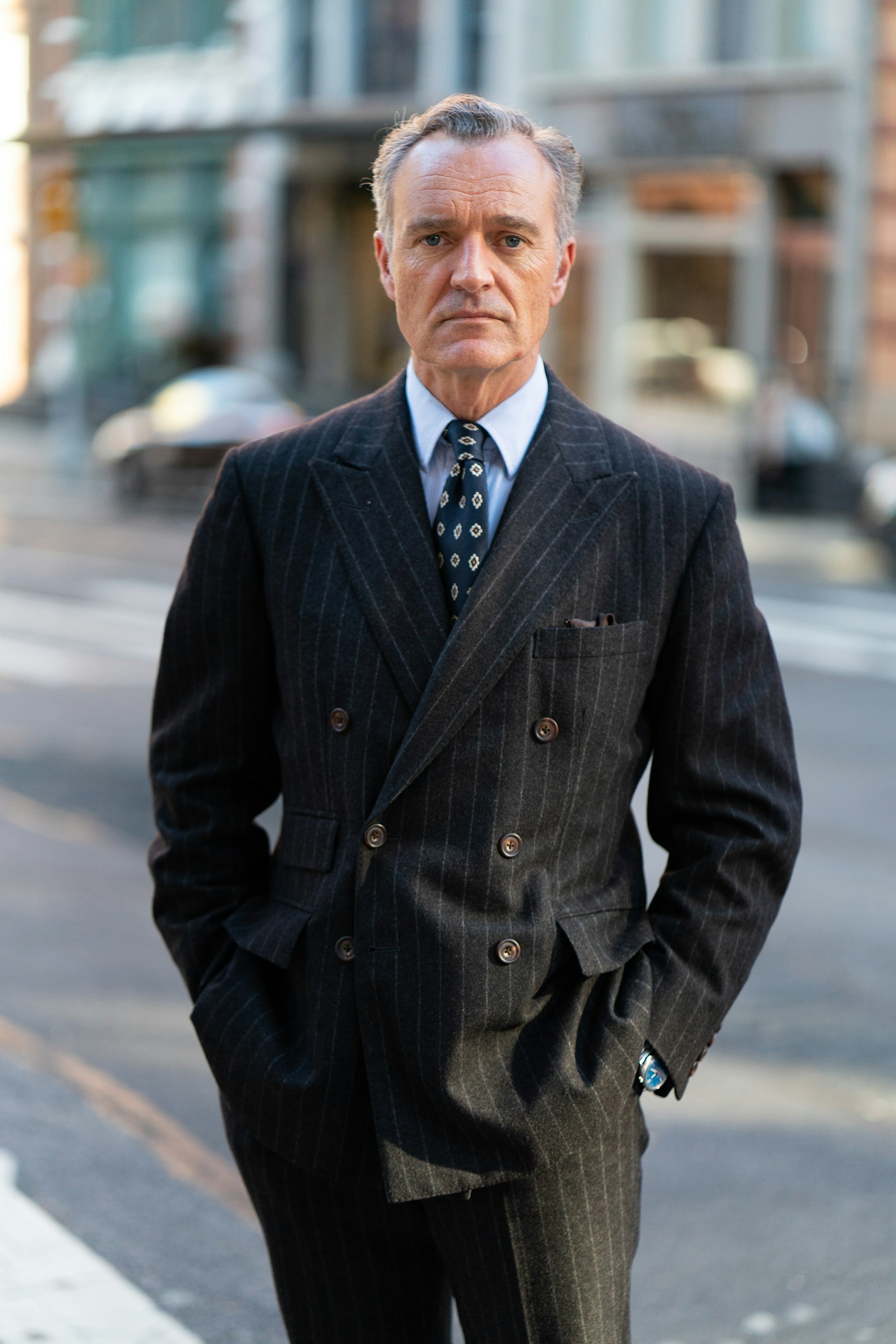
We sat down with Douglas Cordeaux, owner and Managing Director of the legendary British mill, Fox Brothers.
1) Tell us a little about your background. How did you become involved with Fox Brothers?
Before Fox Brothers, I was involved in the textile industry for years, in-fact I’ve only ever worked in fashion and textiles. My first job was printing for British designers in London: Body Map, John Richmond, PX and a whole load of others. Then there was an exciting year in New York for Pepe Jeans and Replay Jeans.
So, why was I drawn to Fox Brothers? The company was introduced to me by Mr Jeremy Hackett. To be honest, the first thing that got my attention was the name. Over lunch at Butlers Wharf, Jeremy told me about the history of the mill and that the archive was second to none. As we were finishing up he said “whatever you do, don’t buy the mill”. Oops!!
I’m now in my tenth year as Managing Director and joint owner with Deborah Meaden. I’m glad we did buy Fox even if the first three years were a nightmare. It was poorly run for decades with no respect for the mill’s heritage, its achievements, and literally zero customer service. It had all left its mark. However, underneath this sea of issues was the brand and an incredibly skilled workforce with a great love of their craft.
I’m glad to report that after a decade Fox is in much better shape. Deborah and I look back on those first three years as “character building”.





2) Can you tell us a little about the history of Fox Brothers? Is there any particular reason it is located in the West of England?
We’re based in Somerset, which is a rarity these days as most mills are known for being in Yorkshire. Three hundred years ago this would not be the case. There would have been dozens of mills producing wool cloth in the West of England. It just happens that we’re the last.
The demand for British Cloth declined at the end of the second World War which was the turning point for the industry’s demise. More cloth was being manufactured overseas due to price, which led to the closure of a lot of the mills. To give some perspective, at the turn of the last century Fox Brothers once directly employed five thousand people.
3) What do you think makes Fox Brothers special?
There’s just something about a Fox Flannel. You can spot it in an instant. I like to say that there’s a bit of Somerset in every metre. Of course the raw materials play an important part but we also weave in the same way that Fox did in the 1920’s. Because of that we’ve always made exceptional cloth, just ask Cary Grant and Fred Astaire.





4) How would you describe your own personal style? Has it changed since you took ownership of Fox?
As the head of the company it's important to dress the part and must admit that I’m slightly obsessed with menswear history.
I really respect the work of the world’s tailors and find it fascinating how styles vary between them. I always think “They do that stuff with their hands!” I’m doing my best to try them all.
5) Fox Brothers, being founded in 1772, is older than the United States. How do you approach managing a company with that much history and heritage?
We see ourselves as custodians of Fox Brothers and its traditions rather than the owners. But, it’s important that the business functions and that we stay relevant. Our design team are always looking to innovate and produce new fabrics. It’s rare to be so design lead but we use our heritage to inform where we’re going in the future.










6) You oversee one of the most extensive cloth archives in the world. How has Fox cloth changed over the years? Are there any trends that you find particularly interesting?
If you’re interested in menswear then our archive is one of the wonders of the World. It’s very much a working archive which our designers will visit on a daily basis.
One of the first things you notice when going through old swatch books is the colours that were used two hundred years ago. We often see classic menswear through black and white photographs so we miss a lot. Those same photographs in color were not blue or grey. At Fox Brothers we’re revisiting colour. Each season we add more, whether that be new colours or forgotten patterns.
7) Cloth is a very three-dimensional product, with weight and texture often as important as color and pattern. In a digital age where customers want to shop remotely, is there a substitute for handling cloth in person?
If you can see the cloth then obviously that’s ideal but today with so much done online it’s important to go with a brand that you can trust. Cloth is so important in tailoring and good cloth is expensive. It’s a fool’s game to try and save a few pounds here. Raw materials, weaving and finishing are all expensive if they’re done well. Choose the right cloth and you’ve got a suit for life and it’ll become a heirloom.
Our 13/14 oz ‘West of England’ flannel woven in Somerset is a perfect example. Everyone, men or women, should have at least one classic Fox Flannel in their wardrobe. The drape is second to none, just ask any bespoke tailor.

8) What are your interests? How do they influence your design choices?
My main area of interest is art and artists. I’m very fond of the Bloomsbury group, in particular the work of Roger Fry. The Omega workshop not only produced paintings but changed people’s lifestyle. They were influencers of their time. They covered painting, ceramics, literature, interiors and fashion.
To keep my head clear, I cycle, I’m not interested in cars. I ride a C-64 Colnago which has all the bells and whistles, it’s my Ferrari. My favourite cycle ride would have to be Alpe d’Huez.
9) What is the Campaign for Wool?
I am fortunate enough to sit on the council for The Campaign for Wool. Our patron is HRH The Prince of Wales, who not only is an ambassador of menswear but also a huge supporter of wool growers.
As a campaign we promote wool worldwide as a sustainable product. It’s biodegradable, which is particularly pertinent as we have a sea full of plastic. It’s really important that we switch back to wool and turn our backs on synthetics.
HRH The Prince of Wales is passionate about the campaign, which has been running for nearly ten years. HRH has been very far sighted on this natural fibre, which has been to great benefit to both grower and weaver. #ChooseWool is the go to hashtag.
10) Looking forward, what you are you most excited about?
Meeting more tailors!





